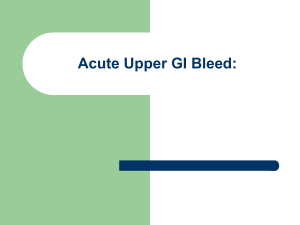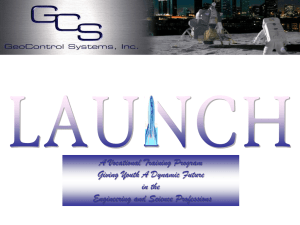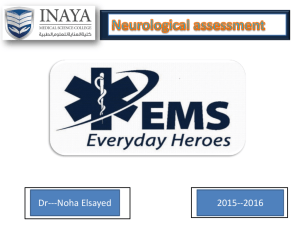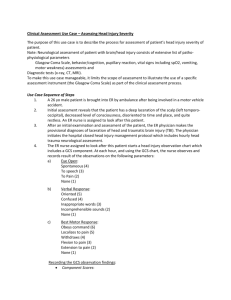Global Service Integration Platform for Network-Centric IOT System Chen Rong Abstract.
advertisement
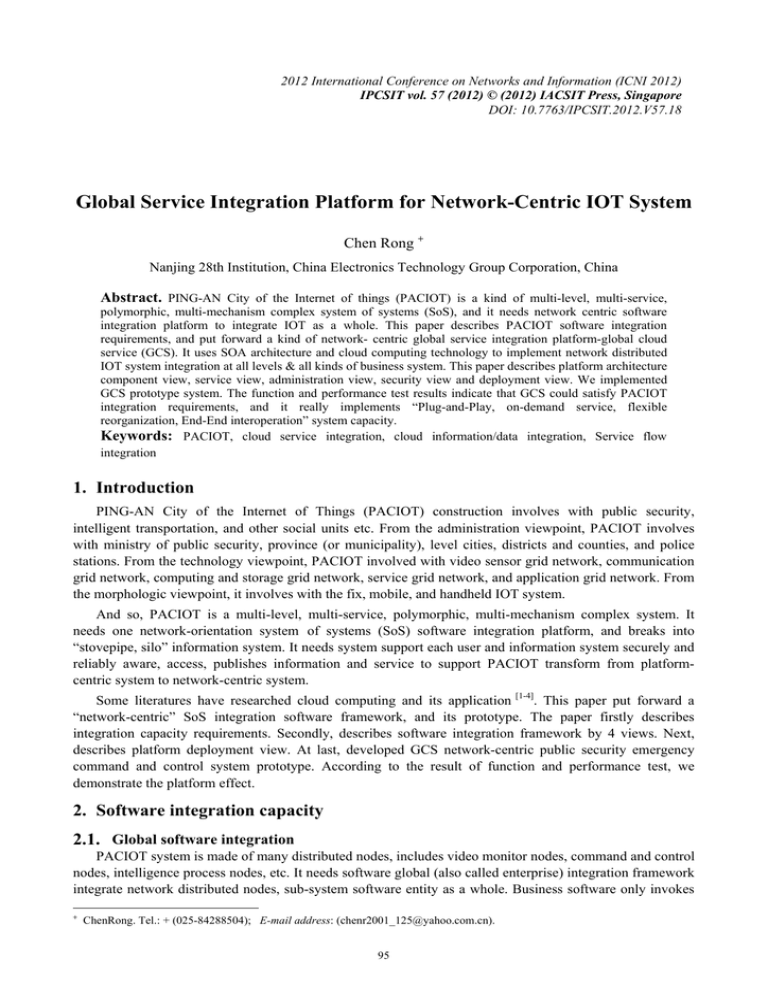
2012 International Conference on Networks and Information (ICNI 2012) IPCSIT vol. 57 (2012) © (2012) IACSIT Press, Singapore DOI: 10.7763/IPCSIT.2012.V57.18 Global Service Integration Platform for Network-Centric IOT System Chen Rong + Nanjing 28th Institution, China Electronics Technology Group Corporation, China Abstract. PING-AN City of the Internet of things (PACIOT) is a kind of multi-level, multi-service, polymorphic, multi-mechanism complex system of systems (SoS), and it needs network centric software integration platform to integrate IOT as a whole. This paper describes PACIOT software integration requirements, and put forward a kind of network- centric global service integration platform-global cloud service (GCS). It uses SOA architecture and cloud computing technology to implement network distributed IOT system integration at all levels & all kinds of business system. This paper describes platform architecture component view, service view, administration view, security view and deployment view. We implemented GCS prototype system. The function and performance test results indicate that GCS could satisfy PACIOT integration requirements, and it really implements “Plug-and-Play, on-demand service, flexible reorganization, End-End interoperation” system capacity. Keywords: PACIOT, cloud service integration, cloud information/data integration, Service flow integration 1. Introduction PING-AN City of the Internet of Things (PACIOT) construction involves with public security, intelligent transportation, and other social units etc. From the administration viewpoint, PACIOT involves with ministry of public security, province (or municipality), level cities, districts and counties, and police stations. From the technology viewpoint, PACIOT involved with video sensor grid network, communication grid network, computing and storage grid network, service grid network, and application grid network. From the morphologic viewpoint, it involves with the fix, mobile, and handheld IOT system. And so, PACIOT is a multi-level, multi-service, polymorphic, multi-mechanism complex system. It needs one network-orientation system of systems (SoS) software integration platform, and breaks into “stovepipe, silo” information system. It needs system support each user and information system securely and reliably aware, access, publishes information and service to support PACIOT transform from platformcentric system to network-centric system. Some literatures have researched cloud computing and its application [1-4]. This paper put forward a “network-centric” SoS integration software framework, and its prototype. The paper firstly describes integration capacity requirements. Secondly, describes software integration framework by 4 views. Next, describes platform deployment view. At last, developed GCS network-centric public security emergency command and control system prototype. According to the result of function and performance test, we demonstrate the platform effect. 2. Software integration capacity 2.1. Global software integration PACIOT system is made of many distributed nodes, includes video monitor nodes, command and control nodes, intelligence process nodes, etc. It needs software global (also called enterprise) integration framework integrate network distributed nodes, sub-system software entity as a whole. Business software only invokes + ChenRong. Tel.: + (025-84288504); E-mail address: (chenr2001_125@yahoo.com.cn). 95 software interface agent and doesn’t care about software entity location, program language, and transfer protocol. 2.2. Global information integration Traditional platform-centric mode command and control system revolves round one node (also called platform-centric) to construction. Network-centric mode command and control system revolves round multinode. From the top level information sharing viewpoint, it needs put multi-point distributed system as a whole SoS design. According to user demand, transfers information resource at correct format, at correct communication means, at correct times, to correct users. It really realizes that “one point information go online, all network system can share”. 2.3. Resources globally Plug and Play PACIOT is a dynamic and open running SoS. It consists of fixed, mobile, and handheld information systems. It is also evolution. Dynamic evolution of SoS needs system have system-level “plug and play” capacity. System-level plug and play capacity requires that SoS have dynamic discovery, binds and invokes software entity capacity, and doesn’t influence SoS operation. 2.4. System globally dynamic organization PACIOT is an evolution of SoS. With the nodes increasing, organization adjusting, business demands changing, SoS should have dynamic reorganization capacity respond to dynamic evolution demands, and implements SoS “adjust to changing circumstances capacity”. 2.5. Distributed command and control support PACIOT supports policeman commander at another node to login into information system, and use local system logined to operate business. After each commander logins system, use local portal accord to schedule policy access business service and data service through integration platform distributed integration capability. 2.6. Global Survivability and reorganization When some service breakdown or failure, application can transparently invoke same function service at another WAN node, and implements SoS high available. Such as IOT municipality node “knowledge service” or“ synthesize position service” failure, it can invoke districts and counties’ “knowledge service” or“ synthesize position service”, and it make SoS continue to work. 3. Software Framework 3.1. Reference Model Global Cloud Service (GCS) major idea is “service-as-center”. In the GCS framework, we abstract every resource as service; it includes business resources, information resources, storage resources, network resources, programming resources, database resources, etc. And so, it uses unify standard interface to manage and access global distributed service. In the GCS, we define cloud service as web service and JMS service, Service=interface/action + service metadata, service can aggregate as different ways. GCS reference model see figure 1. Fig.1: Reference Model GCS reference model consists of hosting environment layer and service model layer framework. The hosting environment can be J2EE or .Net environment. The service model consists of interface, service metadata, and service implementation. GCS interface consists of service interface and other interface. 96 1. Service interface: Service interface is composed of web service interface and jms interface, and must to be implemented. 2.Other interface include notification interface, security interface, resource registry interface, resource discovery interface, resource states interface, service management interface, global address service interface etc. 3.2. Component view GCS consist of core container layer, base service architecture layer, global base application layer, business cooperation and presentation layer, security service and global service management. 1.Core Container Layer(CCL). Core container provides core runtime and core architecture. It mainly includes web server, web container, web application server, logger service, and error service. 2.Base Service Architecture Layer(BSAL). Base service architecture provides global distributed bus, mainly include: directory service, distributed cache service, flow media service, service runtime support, database synchronization service, database storage service. 3.Global Base Application Service Layer(GBASL). GBASL is a common runtime base application service that provided for global information system. It mainly includes resources registry service, directory service, discovery service, information dissemination service, mediation service, resources monitor service, global address service. 4.Business Cooperative and Service Presentation Layer(BCSPL). BCSPL layer provides unify cooperation and service presentation. 5.Security Service(SS). Security service provides repudiation, tamper proofing, secure environment 6.Global Service Management(GSM). GSM provides resources monitor, system configure, deploy management etc. It can unify administration, and escapes administration silo. Fig.2: GCS Component View 3.3. Service View From service view viewpoint, we divide IOT into presentation layer, business service, and service integration layer. 1 Presentation layer. Presentation layer is the access portal for each business system and manage system. It includes business interface, management interface, and business cooperation interface. Interface is expressed by web ways and is integrated by portal system. 2 Service integration layer. Service integration layer provides networked service architecture, including each base service and global application service. The layer target integrates distributed nodes as single node, to implement business service unify monitor, schedule and access. 3 Business service layer. Business service layer is an important part of user application. It includes common application service, private application service and application. User application put local service and remote service into construction on-demand through business process management or programming. 97 Fig.3: Service View 3.4. Administration View GCS provides integrated service administration. It administrates service configuration, management, running, monitor and system help. Fig.4: Administrate View 3.5. Secure View GCS provides secure service, and provides data encryption, data signature, user management, PMI secure safe guarding function. Fig.5: Secure view 4. Platform deployment PACIOT deploys GCS platform on core nodes. It provides resources access, operation management, resources registry, resources discovery, and resources schedule service capacity. 98 Fig.6: Deployment View In the networks distributed resources node (providing service), user node (using service) deploy platform on demand. Among these, users mainly wrap information resources, software resources, computing resources as services by GCS, and registers and publish services. Platforms of user nodes look as a client, and transparently use resources. GCS nodes include fixed nodes, car mobile nodes, handheld nodes and zero client nodes. Though deploying independently and using GCS distributed mechanism, GCS is interconnecting as a whole. Deployment view see figure 6. 5. Prototype system and performance test 5.1. Prototype system instruction Prototype system consists of GCS prototype and emergency command and control system. 1. Prototype system functions and display interface We have developed GCS platform and application service. Application service includes situation awareness, command and control, video monitor, incident management, action monitor, dynamic board service. System function integration interface see figure 7. In the middle of system interface is situation awareness. Fig.7: Commands and control integration interface 2. Network topology Fig.8: distributed network topology Prototype system physical nodes include 7 distributed command and control nodes, one simulation node, one test node and one display node. We use 1000M fiber and router to interconnect system. Node server is 4G memory and 2.1GB CPU, Operating system is Linux 7.0,ORACLE 11g. Network topology see figure 8. 5.2. Performance test results We have tested GCS concurrency performance and per second message. The performance shows as Tab.1 and figure 9. VUsers per Second Hits Tab.1 GCS performance test result Transaction Trans/Sec per Response transaction Time time 99 Delay time(s) VUsers per Second Hits Transaction Response Time Trans/Sec per transactionn time Delay time(s) 300 1726.75 0.018 2905 0.001 0 400 1200 819.97 622.12 0.022 0.013 2079 1929 0.001 0.001 0 1 m message /s 500 000 41557 35903 14 18623 2051 20690 24647 10889 9942 213988 643 76 0 1 2 3 4 5 6 7 8 9 10 Fig.9: per seecond messagee performancee 6. Concllusion Compleex informatioon system esspecially com mplex IOT needs n one claass integratioon mechanism integratess all levels & all kinds of softwaree subsystem m for plug and a play, annd flexible rreorganizatio on capacity.. Traditional component oriented orr enterprise service bus is difficult to integratee PACIOT–like system.. Through prrototype systtem construcction and teest, GCS meechanism cann effectivelyy integrate software s andd informationn resource forr PACIOT-liike system. 7. Referrences [1] MELL P, P GRANCE T. T The NIST Definition D of Cloud C Computing[R]. Nationnal Institute oof Standards an nd Technoology, 2011. [2] FOSTER R I, YONG Z,, RAICU I, et al. Cloud Com mputing and Grid G Computiing 360-Degreee Compared [Z]. 2008.110. NBERG A, HA AMILTON J, MALTZ M D A,, et al. The cosst of a cloud: research probblems in data center [3] GREEN networkks [J]. SIGCO OMM Comput Commun Revv, 2008, 39: 68-73. 6 [4] GUO C,, LU G, LI D, et al. BCube: a high perforrmance, server-centric netw work architectture for modullar data centers [A]. SIGCOM MM'09[C]. Baarcelona, Spaiin: ACM, 2009.63-74. PADI V, STAR RIKOVSKIY A. The on deemand governo or: past, preseent and futuree[A]. Proceediings of Linux [5] PALLIP Sympossium[C]. 20066. 223-238. [6] DECAN NDIA G, HASTORUN D, JA AMPANI M, et al. Dynamo o: Amazon’s highly h availabble key-value store[A]. s SOSP'007[C]. Stevensson, Washingtton, USA: AC CM, 2007.205--220. [7] Zeng Annli, Meng Qinnghu, et al. Sofftware Technoology in cloud d computing arrchitecture forr net-centric command c informaation system[JJ]. Command Information I syystem and tecchnology,20111,6:15-22. [8] Yi Kan,H Huang Songhuua,Ding Fengg. Grid computing service fo or military appplication systeem [J]. Comm mand Informaation system and a technologyy,2011,6:24-228. Ch hen Rong, 1975.10 1 bornn in Yancheng, Jiang Suu province, tthe people’ss republic off Chhina. He graaduated at Zhejiang Un niversity and got thhe computerr science & tecchnology docctor degree at 2005. An nd he has worked w for N Nanjing 28th h Institutionn (Chhina Electroonics Technoology Group p Corporatioon) about 7 years, and engages inn com mplex system m integrationn job. 100

